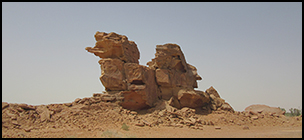Crossref Citations
This article has been cited by the following publications. This list is generated based on data provided by
Crossref.
Andreae, Meinrat O.
Al‐Amri, Abdullah
Andreae, Claire M.
Guagnin, Maria
Jochum, Klaus Peter
Stoll, Brigitte
and
Weis, Ulrike
2020.
Archaeometric studies on the petroglyphs and rock varnish at Kilwa and Sakaka, northern Saudi Arabia.
Arabian Archaeology and Epigraphy,
Vol. 31,
Issue. 2,
p.
219.
Guagnin, Maria
Charloux, Guillaume
AlSharekh, Abdullah M.
Crassard, Rémy
Hilbert, Yamandú H.
Andreae, Meinrat O.
AlAmri, Abdullah
Preusser, Frank
Dubois, Fulbert
Burgos, Franck
Flohr, Pascal
Mora, Pascal
AlQaeed, Ahmad
and
AlAli, Yasser
2022.
Life-sized Neolithic camel sculptures in Arabia: A scientific assessment of the craftsmanship and age of the Camel Site reliefs.
Journal of Archaeological Science: Reports,
Vol. 42,
Issue. ,
p.
103165.
Hilbert, Yamandú H.
Clemente-Conte, Ignacio
Crassard, Rémy
Charloux, Guillaume
Guagnin, Maria
and
AlSharekh, Abdullah M.
2022.
Traceological analysis of lithics from the Camel Site, al-Jawf, Saudi Arabia: an experimental approach to identifying mineral processing activities using silcrete tools.
Archaeological and Anthropological Sciences,
Vol. 14,
Issue. 5,
Charloux, Guillaume
Guagnin, Maria
Petraglia, Michael
and
AlSharekh, Abdullah
2022.
A rock art tradition of life-sized, naturalistic engravings of camels in Northern Arabia: new insights on the mobility of Neolithic populations in the Nafud Desert.
Antiquity,
Vol. 96,
Issue. 389,
p.
1301.
Guagnin, Maria
Shipton, Ceri
Stileman, Finn
Jibreen, Faisal
AlSulaimi, Malek
Breeze, Paul S.
Stewart, Mathew
Hatton, Amy
Drake, Nick
Jha, Deepak Kumar
Al-Tamimi, Fahad
Al-Shamry, Mohammed
Al-Shammari, Mishaal
Kay, Andrea
Groucutt, Huw S.
Alsharekh, Abdullah M.
and
Petraglia, Michael
2023.
Before the Holocene humid period: Life-sized camel engravings and early occupations on the southern edge of the Nefud desert.
Archaeological Research in Asia,
Vol. 36,
Issue. ,
p.
100483.
